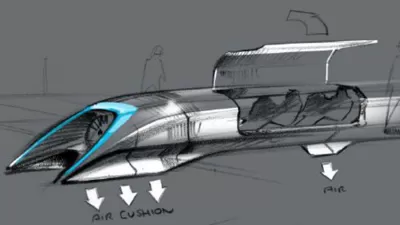After another big announcement from the realm of futuristic transportation, there's reason to remain skeptical.

Alissa Walker reports the news that Hyperloop One recently released a plan for 11 Hyperloop routes connecting 35 major cities earlier this month.
Vision for America, as the plan is called, "would connect 83 million Americans, including routes linking Los Angeles to San Diego, Dallas to Austin, Texas, and a mega-route serving cities from Cheyenne to Houston," according to Walker. "The routes are the U.S. finalists for a Hyperloop One competition, where teams submitted proposals for the most promising Hyperloop corridors around the world, based on estimated ridership and economic potential."
Hyperloop One’s senior business analyst Rehi Alaganar writes a post to explain the plan, comparing the vision for the Hyperloop to the Interstate Highway System.
Angie Schmitt also wrote on the subject of the Hyperloop this week, noting that the ides has yet to deliver a functional, real-world example of the technology. "Anyone who believes it’s a viable endeavor is basically taking it on faith," writes Schmitt. Yet, Schmitt notes, "a surprising number of government agencies are treating the Hyperloop as a serious proposition." Schmitt's article lists some of the agencies that seem to be buying into the Hyperloop hype before responding directly to some of the talking point that companies like Hyperloop One are relying on to market the idea. Schmitt's final assessment: "America has the means to reduce traffic and connect people to where they want to go in less time — but solving these problems entails politically difficult choices to shift travel away from cars and highways. Any high-tech solution that promises a shortcut around these thorny problems is probably too good to be true."
FULL STORY: Hyperloop One reveals plan to connect 35 U.S. cities

Maui's Vacation Rental Debate Turns Ugly
Verbal attacks, misinformation campaigns and fistfights plague a high-stakes debate to convert thousands of vacation rentals into long-term housing.

Planetizen Federal Action Tracker
A weekly monitor of how Trump’s orders and actions are impacting planners and planning in America.

In Urban Planning, AI Prompting Could be the New Design Thinking
Creativity has long been key to great urban design. What if we see AI as our new creative partner?

Massachusetts Budget Helps Close MBTA Budget Gap
The budget signed by Gov. Maura Healey includes $470 million in MBTA funding for the next fiscal year.

Milwaukee Launches Vision Zero Plan
Seven years after the city signed its Complete Streets Policy, the city is doubling down on its efforts to eliminate traffic deaths.

Portland Raises Parking Fees to Pay for Street Maintenance
The city is struggling to bridge a massive budget gap at the Bureau of Transportation, which largely depleted its reserves during the Civd-19 pandemic.
Urban Design for Planners 1: Software Tools
This six-course series explores essential urban design concepts using open source software and equips planners with the tools they need to participate fully in the urban design process.
Planning for Universal Design
Learn the tools for implementing Universal Design in planning regulations.
Gallatin County Department of Planning & Community Development
Heyer Gruel & Associates PA
JM Goldson LLC
City of Camden Redevelopment Agency
City of Astoria
Transportation Research & Education Center (TREC) at Portland State University
Jefferson Parish Government
Camden Redevelopment Agency
City of Claremont




























